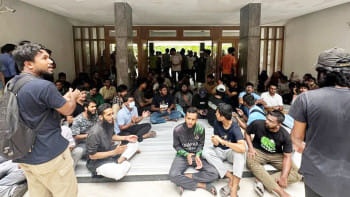The state of our student politics

The recent fiasco at Dhaka University (DU), involving a tussle between Chhatra League (BCL) and the protesters against sexual assault, stems from a grossly wrong-headed and reckless administrative decision. It all began when Dhaka University took over the responsibility of seven major colleges in Dhaka from the National University (NU).
According to multiple media reports, the mutual animosity between a former VC, AAMS Arefin Siddique, and a former Pro-VC of DU, who happens to be the VC of NU, might have motivated the former to push for the change.
In spite of the remarkable progress that the National University had made in crushing its notorious session-jams, the education ministry conceded to Siddique's persistence. In the months since, a prolonged, chaotic and extemporaneous transition process has ensued.
Meanwhile, the former VC of DU had to step down, as the government decided to replace him with Mohammad Akhtaruzzaman, widely seen as supported by the ex- VC's opponents.
While Akhtaruzzaman has so far refrained from openly criticising his predecessor and former boss, the new administration admittedly hinted that it did not have adequate preparation to take on the responsibility of these seven colleges, whose size of students are five times that of Dhaka University.
Both the students of these seven colleges and Dhaka University opposed and protested the move, albeit for different reasons. The students of the seven colleges saw their education get plunged into an unending chaos, while academic operations in the other colleges around the country were running smoothly. The students of the 2014-15 session of these colleges, for example, are yet to get their results, although they had taken their exam a year ago.
They often took to the streets to express their frustration. In one such protest rally in July last year, Siddiqur Rahman, a student of Titumir College, lost his vision when police threw a tear-gas canister. Instead of addressing the outcry over the brutality, the police filed a case against an unspecified number of student protesters. The withdrawal of this case has been included in the students' list of demands, which no one cares to meet.
On the other hand, Dhaka University students protested the move as they believe that the affiliation would further strain their already overburdened, understaffed and overstretched university. They were also concerned over what they saw as a growing assimilation of the students of these colleges into their university. For example, the fact that the admission process of new students of these seven colleges—32,000 in total—was carried out on DU's campus unsettled its own students.
And the Chhatra League cashed in on this. As detailed in a report by this newspaper on January 30, the leaders of DU units of BCL initially supported and encouraged the students who had arranged a protest rally on January 11, demanding the affiliation process be cancelled. However, the university authorities dodged the protesters and talked directly to BCL leaders, whom they believed were pulling the strings, and asked them to douse the flames. Accordingly, the BCL leaders tried to persuade the protesters to call off their demonstration by saying that the VC would resolve the issue.
Unconvinced, the students decided to continue their protests and staged a sit-in five days later in front of the VC's office—this time without any backing from BCL. Around half an hour later, after having been summoned by the VC, a few hundred BCL activists, led by its top leaders, appeared at the spot and asked the protesters to stop their demonstration. As the two parties engaged in a scuffle, BCL activists hurled abuses at the female demonstrators and had even sexually assaulted them. In the end, the demonstration was foiled, and the university authorities lodged a case against the protesters.
That is when the nature of the movement abruptly changed, with left-leaning organisations aligning themselves with the demonstrators. On January 23, the protesters again gathered in front of the VC's office with four new demands, including the resignation of the proctor, punishment of BCL activists who had assaulted the female protesters, and the withdrawal of the case lodged against the students. The left-leaning organisations brought a change in the initial demand of the protesters. Instead of demanding an outright cancellation of affiliation, they called on the DU authorities to "resolve" the ongoing crisis. That was a sensible change, on their part.
As the protesters broke into the VC's office and confined him, hundreds of BCL activists came to his "rescue", reportedly, at his request.
Everyone knows the rest of the story. Protesters were outnumbered and forced to retreat. The following day, a bunch of front-page photos in this newspaper showed how female protesters were assaulted by the BCL's female activists.
For many on social media, the incident brought back memories of the infamous Shamsunnahar Hall tragedy in 2002, when activists of the then-ruling party affiliated Chhatra Dal and police stormed the hall and assaulted female protesters.
The entire episode showed how a petty internal strife among some influential teachers had a far-reaching consequence for tens of thousands of students. Interestingly, DU units of BCL thought that the demands raised by the general students were legitimate and, thus, supported them, but when the high-ups signalled their opposition, BCL could not maintain a shred of its integrity or independence. So, what's the point of having a student organisation that cannot determine its own position?
The whole saga is a reminder of the degraded and sorrowful state that our student politics is in today and of student political organisations whose position only overlaps that of their respective parent organisation, not that of students.
Nazmul Ahasan is a member of the editorial team at The Daily Star.





Comments